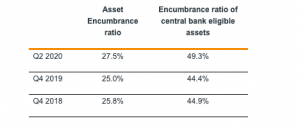The European Banking Authority (EBA) recently published its annual report on Asset Encumbrance. As COVID-19 spread across Europe and activity in primary markets froze, banks made extensive use of central bank liquidity facilities to build precautionary liquidity buffers. In this context, after decreasing by 80bp in 2019 to 25%, in the first half of 2020, the asset encumbrance ratio went up to 27.5%. In the first half of 2020, the volume of total assets and collateral received rose by almost 10% while encumbered assets and collateral increased by more than 20%.
Overview of key figures
The extensive use of the extraordinary central bank liquidity facilities in 2020 has driven up the share of central bank funding over total sources of encumbrance. In contrast, the attractive conditions of central bank facilities have led many banks to reduce their reliance on covered bonds. Repos, whose share has remained roughly stable, were the most important source of encumbrance in 2020.
Almost half of total central bank eligible assets were encumbered in June 2020. Nonetheless, banks increased their stock of unencumbered central bank eligible assets and collateral by more than 10% in the first half of 2020.
Supervisory authorities should pay special attention to the increased reliance on central bank funding. Although the recent increase in the asset encumbrance ratio is not a concern by itself, banks’ capacity to further make use of central bank funding when necessary should be monitored.
Conclusion
The main rationale for the monitoring of asset encumbrance is related to the potential consequences of changes in banks’ funding sources, such as an increase in the use of secured funding due to reduced access to unsecured instruments or a move towards transactions that require collateral posting such as derivatives.
In 2019, the asset encumbrance ratio declined slightly as banks reduced their reliance on secured funding sources. However, this trend was reverted when COVID-19 hit Europe. As activity in primary wholesale funding markets came to halt in the spring of 2020, banks resorted to extraordinary central bank facilities to build precautionary liquidity buffers and to attend the increase in loan demand from non-financial corporates.
The favourable conditions of central bank facilities led also to a reduction in covered bond issuance. As a result, the weight of central bank funding as a source of encumbrance has registered a steep increase at the expense of covered bond funding.
Although wholesale funding markets have stabilised and issuances have resumed, supervisory authorities should pay attention to the developments regarding the encumbrance ratio of central bank eligible assets. As of June 2020, almost half of these assets were already encumbered.
Source: EBA



